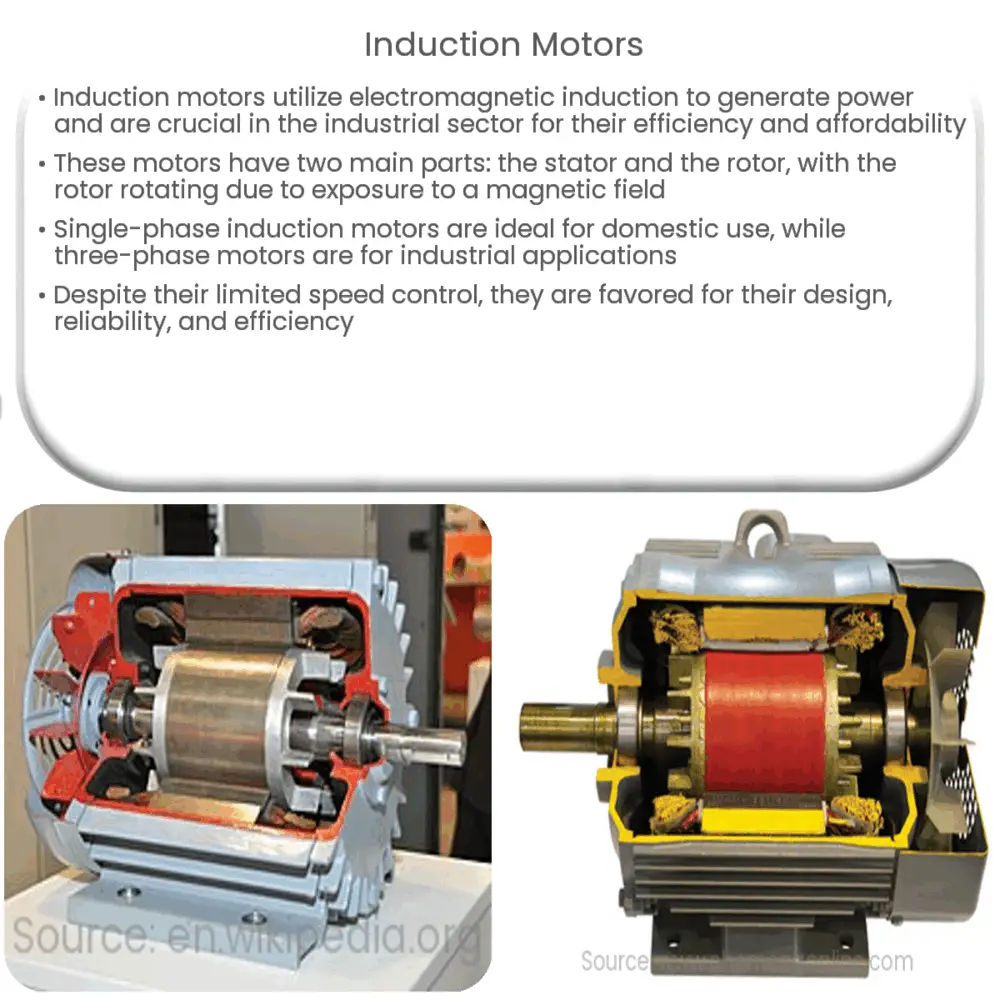Explore the world of Induction Motors: Understand their operation, types, applications in industries, home appliances, and EVs, and their future potential.

Understanding Induction Motors
Induction motors, also referred to as asynchronous motors, are a type of electric motor that utilizes electromagnetic induction to generate mechanical power. These motors have been an integral part of the industrial sector due to their robustness, affordability, and high efficiency.
Working Principle
The operation of an induction motor revolves around two primary parts – the stator and the rotor. The stator, the stationary part of the motor, is made up of a series of coils. When an alternating current (AC) passes through these coils, it generates a rotating magnetic field. The rotor, the moving part, is located inside the stator and is subject to this magnetic field.
The principle of electromagnetic induction causes the rotor to rotate when it is exposed to the magnetic field. This happens due to the induced current generated in the rotor as a result of the changing magnetic field. The frequency of the rotating magnetic field is the same as the frequency of the AC supply, while the speed of the rotor is slightly less than the speed of the magnetic field. This difference in speed is called the “slip.
Types of Induction Motors
- Single Phase Induction Motors: These motors are used in domestic and light industrial applications, where the supply is single-phase AC. These motors are smaller in size and cheaper.
- Three Phase Induction Motors: In contrast, three-phase induction motors are employed in industries for heavy-duty applications. They are larger, more efficient, and provide a higher torque compared to single-phase motors.
Characteristics of Induction Motors
Induction motors exhibit several important characteristics that make them ideal for various applications:
- They operate at a constant speed irrespective of the load, making them suitable for applications requiring uniform motion.
- They are simple in design, reliable, and require minimal maintenance.
- They possess high efficiency and power factor which increases with the load.
However, one limitation of induction motors is their lack of speed control compared to other types of motors, such as DC motors or servo motors.
Applications of Induction Motors
The versatility and durability of induction motors make them suitable for various applications. In the following sections, we will delve deeper into these applications and discuss the impact of induction motors in different industries.
Applications in Industrial Sector
Induction motors play a significant role in industrial applications due to their high power output and ruggedness. They are commonly used in industries such as manufacturing, where they power large machines and conveyors. In the oil and gas industry, these motors are used for driving compressors, pumps, and fans.
Applications in Domestic Appliances
On the smaller end of the scale, single-phase induction motors are found in many household appliances. These include refrigerators, air conditioners, washing machines, and fans, where the motor’s purpose is to convert electrical energy into mechanical energy to perform a certain task.
Applications in Electric Vehicles
With the rise of electric vehicles (EVs), induction motors have found a new application. They are used in some EVs due to their light weight, high-speed operation, and the absence of magnets, which can be a significant cost and supply chain concern.
Future of Induction Motors
The importance of induction motors is likely to continue in the future. As industries become increasingly automated and the demand for electric vehicles grows, the need for efficient, robust, and cost-effective motors will increase. Furthermore, ongoing research and development are aiming to enhance the control of induction motors to overcome their inherent speed control limitation.
Conclusion
In conclusion, induction motors are an integral part of our daily lives, from the appliances we use at home to the industries that shape our economy. Their principles of operation, types, and characteristics make them uniquely suited for a wide range of applications. Despite their few limitations, their advantages far outweigh their drawbacks, making them a preferred choice for many applications. As technology continues to advance and the world becomes more electrified, induction motors’ importance will only grow, highlighting the need for ongoing research and innovation in this field.

